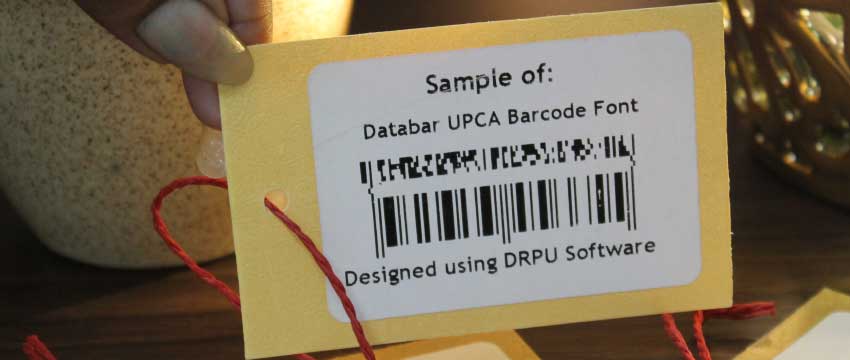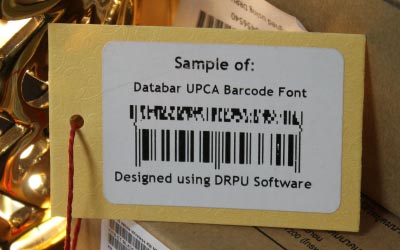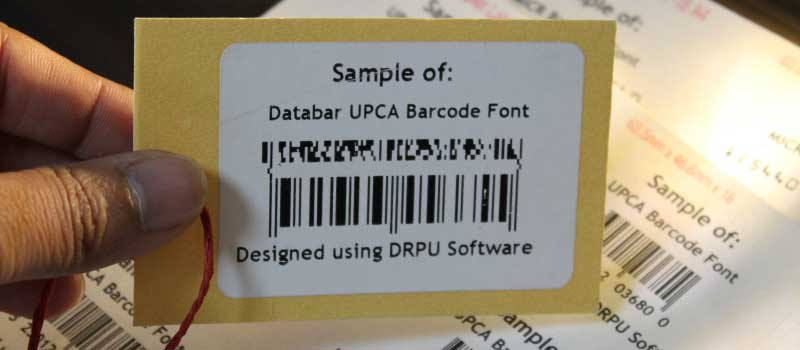Types of Barcodes
There are several types of barcodes, each with their own unique characteristics and uses. The most common types of barcodes include Code 39, Code 128, QR code, and Databar UPCA.

-
Code 39:
Code 39 is a linear barcode that is commonly used in manufacturing and logistics. It can store up to 43 characters and is made up of a series of bars and spaces that represent each character. Code 39 is a variable length barcode, which means that it can store different amounts of information depending on the size of the label or package.
-
Code 128:
Code 128 is a linear barcode that is commonly used in shipping and logistics. It can store up to 128 characters and is made up of a series of bars and spaces that represent each character. Code 128 is a variable length barcode, which means that it can store different amounts of information depending on the size of the label or package.
-
QR Code:
QR code is a two-dimensional barcode that is commonly used in marketing and advertising. It can store up to 7,000 characters and is made up of a series of black and white squares that represent each character. QR code can store more information than linear barcodes and can also include images and logos.
-
Databar UPCA:
Databar UPCA is a linear barcode that is commonly used in retail and grocery stores. It can store up to 12 digits of information and is made up of a series of bars and spaces that represent each digit. Databar UPCA can also include additional information such as weight or price.
Introduction of Databar UPCA Barcode
I believe there might be a typo in your question, as "Databar UPCA" barcode is not a commonly used barcode standard. However, I will provide an explanation of UPCA barcodes, which are widely used in retail and logistics industries.
The UPCA barcode consists of 12 digits and is made up of four components: a quiet zone, a start character, a data character, and a stop character. The quiet zone is a blank area at the beginning and end of the barcode that provides a clear area for the barcode scanner to detect the barcode. The start character is a unique pattern that indicates the beginning of the barcode. The data characters represent the unique product identifier, which consists of a manufacturer code and a product code. The stop character is a unique pattern that indicates the end of the barcode.
The UPCA barcode can be scanned by a barcode scanner, which uses a laser or camera to read the black and white bars and spaces. The scanner converts the barcode into a digital signal, which is then decoded into the 12-digit product identifier.

UPCA barcodes are commonly used in retail and logistics industries to track inventory and sales. They allow for quick and accurate scanning of products, reducing the likelihood of errors and improving efficiency. UPCA barcodes are also used to provide product information to consumers, such as pricing and product descriptions.
UPCA barcodes have several advantages over other barcode symbologies. They are widely recognized and supported by barcode scanning technology, making them an industry standard. They can be easily printed on labels, packaging, and other materials, and are relatively inexpensive to produce. Additionally, UPCA barcodes are capable of encoding a large amount of information in a small space, making them ideal for use on small products.
However, UPCA barcodes do have some limitations. They are a 1D barcode, meaning they can only encode a limited amount of information. They also require a clear and unobstructed line of sight for accurate scanning, which can be challenging in some situations. Additionally, UPCA barcodes can be difficult to read if they are damaged or poorly printed, which can lead to errors in scanning and processing.
UPCA barcodes are a widely used barcode symbology for tracking trade items in retail and logistics industries. They encode a unique 12-digit product identifier in a series of black and white bars and spaces, and can be easily scanned by barcode scanners for quick and accurate tracking of inventory and sales. While they have some limitations, UPCA barcodes are an industry standard due to their wide recognition and support, ease of printing, and ability to encode a large amount of information in a small space.
Databar UPCA Barcode Differ from other Types of Barcodes
A Databar UPCA barcode, also known as a Universal Product Code-A, is a type of linear barcode that is commonly used in retail and grocery stores. It differs from other types of barcodes in several ways.
-
Capacity:
The Databar UPCA barcode can store up to 12 digits of information, which is more than the traditional UPC barcode that can only store up to 11 digits of information. This extra digit allows for more specific product identification, such as variations in size, color, or flavor. In comparison, Code 39 can store up to 43 characters, Code 128 can store up to 128 characters, and QR code can store up to 7,000 characters.
-
Scanning Capability:
Databar UPCA barcode scanners are capable of reading traditional UPC barcodes, but not all traditional scanners are capable of reading Databar UPCA barcodes. This means that retailers and manufacturers may need to invest in new barcode scanners to support the use of Databar UPCA barcodes. Code 39 and Code 128 scanners are commonly available and can read both types of barcodes, while QR code scanners are also widely available.
-
Size:
Another advantage of the Databar UPCA barcode is its size. It is smaller than the traditional UPC barcode, which allows for more products to be placed on a shelf or in a display. In comparison, Code 39 and Code 128 are also linear barcodes and are similar in size to the Databar UPCA barcode, while QR code is a two-dimensional barcode and is generally larger.
-
Additional Information:
In addition to the 12-digit product identification number, the Databar UPCA barcode can also include additional information such as the weight or price of the product. This allows for more efficient inventory management and pricing. Code 39 and Code 128 can also include additional information, but QR code can store more detailed information such as images and logos.
-
Usage:
Databar UPCA is primarily used in retail and grocery stores, while Code 39 and Code 128 are commonly used in manufacturing and logistics. QR code is commonly used in marketing and advertising, but can also be used in other industries such as transportation and healthcare.
Summary: A Databar UPCA barcode differs from other types of barcodes in its capacity, size, ability to include additional information, usage, and scanning capability. It is primarily used in retail and grocery stores and can store more information than traditional UPC barcodes while also being smaller in size. However, it may require retailers and manufacturers to invest in new barcode scanners to support its use.
Purpose of Using a Databar UPCA Barcode
The purpose of using a Databar UPCA barcode, also known as a Universal Product Code-A barcode, is to provide a standardized way to identify and track products in the retail and grocery industries. This type of barcode is used to automate the process of identifying and tracking products as they move through the supply chain, from manufacturing to the point of sale.
There are several reasons why a Databar UPCA barcode is used:
-
Product Identification:
The primary purpose of a Databar UPCA barcode is to identify a specific product. Each product is assigned a unique 12-digit number, which is encoded in the Databar UPCA barcode. This number allows retailers and manufacturers to identify a specific product and its different variations, such as size, color, and flavour.
-
Inventory Management:
The use of Databar UPCA barcodes enables more efficient inventory management. Retailers can use barcode scanners to quickly and accurately track the movement of products in their stores. This allows them to monitor stock levels, identify which products are selling well, and reorder products before they run out of stock.
-
Quality Control:
The use of Databar UPCA barcodes also enables quality control. Manufacturers can use barcode scanners to quickly and accurately identify products that may be defective or have quality issues. This allows them to quickly remove these products from the supply chain and prevent them from reaching retailers or consumers.
-
Pricing:
Databar UPCA barcodes can also be used to automate pricing. The barcode can include the price of the product, which is then automatically added to the point of sale system when the product is scanned by the barcode scanner. This reduces the time and effort required for manual pricing and eliminates the possibility of errors in pricing.
-
Tracking:
Another purpose of Databar UPCA barcodes is to track the movement of products through the supply chain. Barcodes can be scanned at various points in the supply chain, such as at the manufacturing facility and at the retailer's distribution center. This allows manufacturers and retailers to track the location of products, monitor their movement through the supply chain, and identify any issues or delays that may arise.
-
Consumer Experience:
Databar UPCA barcodes can also improve the consumer experience. By scanning the barcode at the point of sale, retailers can quickly and accurately identify the product and its price, reducing the time spent waiting in line. Additionally, the barcode can be used to provide consumers with additional information about the product, such as nutritional information or cooking instructions.
The purpose of using a Databar UPCA barcode is to provide a standardized way to identify and track products in the retail and grocery industries. The barcode allows for efficient product identification, inventory management, pricing, tracking, quality control, and improved consumer experience.
Information That can be Encoded in a Databar UPCA Barcode
A Databar UPCA barcode, also known as a Universal Product Code-A barcode, can encode several types of information. The barcode consists of a series of black and white bars, with each bar representing a binary digit (0 or 1). The specific pattern of bars represents a unique product identification number, which can be used to identify a product in the retail and grocery industries. The following information can be encoded in a Databar UPCA barcode:

-
01
Product Identification Number:
The primary piece of information encoded in a Databar UPCA barcode is the product identification number. This number is unique to each product and is assigned by the manufacturer. The product identification number is a 12-digit code, with each digit representing a specific piece of information. The first six digits of the code represent the manufacturer's identification number, while the next five digits represent the product code. The final digit is a check digit, which is used to verify the accuracy of the barcode.
-
02
Price:
The price of the product can also be encoded in a Databar UPCA barcode. This allows retailers to automate the pricing process and ensures that the correct price is applied to the product at the point of sale. The price is typically encoded in the barcode using a special format, which allows the barcode scanner to identify that the barcode contains price information.
-
03
Weight:
The weight of the product can also be encoded in a Databar UPCA barcode. This is particularly useful for products that are sold by weight, such as meat or produce. The weight is typically encoded in the barcode using a special format, which allows the barcode scanner to identify that the barcode contains weight information.
-
04
Expiration Date:
The expiration date of the product can also be encoded in a Databar UPCA barcode. This allows retailers to automate the process of removing expired products from their shelves and ensures that consumers do not purchase expired products. The expiration date is typically encoded in the barcode using a special format, which allows the barcode scanner to identify that the barcode contains expiration date information.
-
05
Batch Number:
The batch number of the product can also be encoded in a Databar UPCA barcode. This allows manufacturers to track the movement of products through the supply chain and identify any issues that may arise. The batch number is typically encoded in the barcode using a special format, which allows the barcode scanner to identify that the barcode contains batch number information.
-
06
Serial Number:
The serial number of the product can also be encoded in a Databar UPCA barcode. This allows manufacturers to track the movement of individual products through the supply chain and identify any issues that may arise. The serial number is typically encoded in the barcode using a special format, which allows the barcode scanner to identify that the barcode contains serial number information.
-
07
Country of Origin:
The country of origin of the product can also be encoded in a Databar UPCA barcode. This is useful for products that are imported from other countries and need to be labeled with the country of origin. The country of origin is typically encoded in the barcode using a special format, which allows the barcode scanner to identify that the barcode contains country of origin information.
Summary: A Databar UPCA barcode can encode several types of information, including the product identification number, price, weight, expiration date, batch number, serial number, and country of origin. This information is encoded in the barcode using a special format, which allows the barcode scanner to identify the type of information contained in the barcode.